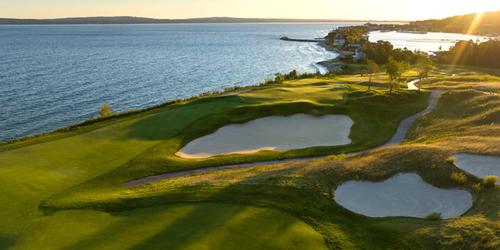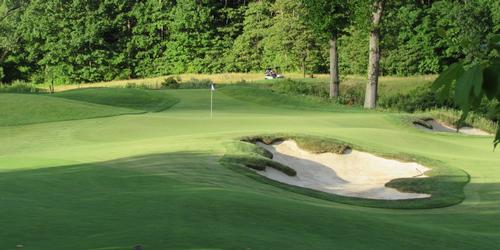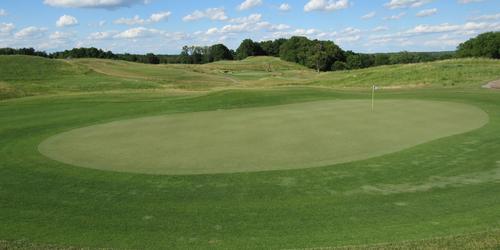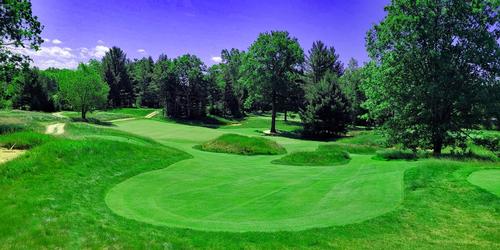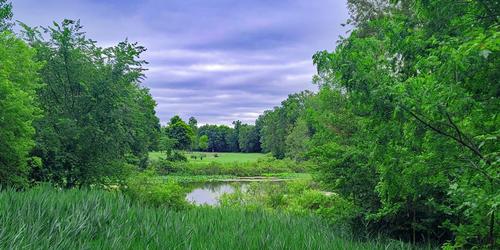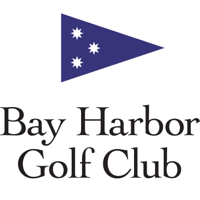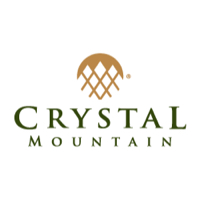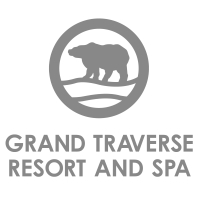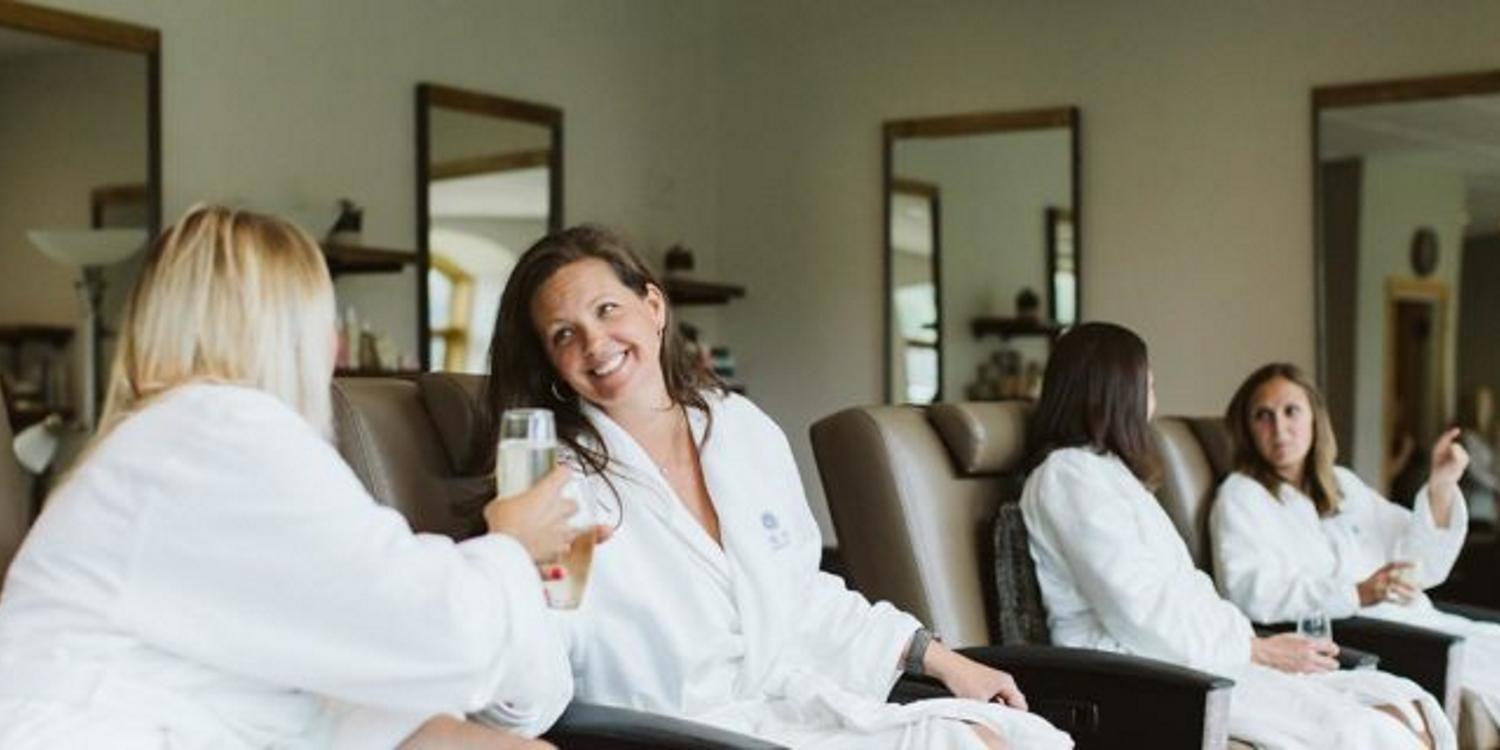
Boyne Highlands Resort: A four-course feast of golf
By Kiel Christianson
Summer is admittedly short, but if, say, you own a ski resort, and your hotel and sprawling grounds feel abandoned during the long, sun-drenched yet temperate days from May through October in the northern reaches of the state's southern peninsula, you might well consider expanding your warm-weather offerings. After all, ski season is also only about six months long. Why not cater to both seasons?
That was the thinking at Boyne Highlands Resort in Harbor Springs, Michigan. The first golf course was built here in 1966. Designed by legendary golf course architect Robert Trent Jones, The Heather (4,485-7,143 yards) opened in 1966, presaging the "golf boom" by some three decades and establishing Boyne as a central player in Michigan golf. The Heather Course has played host over the decades to nearly every major Michigan amateur championship and remains the top draw at the Highlands Resort.
Next came The Moor Course (5,099-6,850 yards), by Bill Newcombe and John Robinson, in 1974, which many locals and regulars will tell you is their favorite (perhaps partially because it tends to be less expensive and less crowded than the other three courses on the resort grounds).
In 1989, the Donald Ross Memorial Course (4,935-6,814 yards) ushered in the "golf boom" years. Also designed largely by Michigan course architect Bill Newcombe, the Ross is an 18-hole homage to legendary Donald Ross. Each hole is modeled after Ross's most famous holes around the world. The greens, especially, are every bit as diabolical as any authentic Ross design you may encounter.
The final course added to the Boyne Highlands property was the eponymous Arthur Hills Course (4,811-7,312 yards, par 73), which, along with the spectacular Bay Harbor Golf Club a few miles away, cemented Hills's reputation as a master of dramatic, and dramatically difficult, golf course design. The Hills Course opened in 1995 (with a redesign in 1999) and has the highest slope rating (144) and course rating (75.4) on the property. It also has the most memorable and visually striking holes at the resort.
Players' notes
The Heather Course
Robert Trent Jones, Sr. innovated a number of golf course design features: long, narrow teeing grounds allowing for extremely variable hole lengths; deep, narrow greens; drifting, meandering doglegged fairways that encourage shots to find preferred angles and require players to move the ball in all directions. All of these RTJ hallmarks are in full display at The Heather Course. Most of all, the layout epitomizes the legendary course architect's mantra of "Easy bogey, difficult par."
The main advice from John Myers, Head PGA Professional at Boyne Highlands, for first-time visitors to The Heather is that "par 3s play longer than the yardage on the scorecard." Also, says Myers, "If the green read is not obvious, the ball will break away from the mountain."
As my son and I worked our way around The Heather, we found quickly that yes, indeed, the par 3s all play longer than they say on the card. We played the conservative orange tees (6,207 yards), but even so, the 162-yard 4th hole, which plays completely over water, felt 20 yards longer. I can only imagine how daunting it would be from the 202-yard back tees.
Our favorite holes were the closing holes on each side. The par-5 9th stretches to a brawny 617 yards from the tips. The fairway snakes left-to-right and then back right-to-left, terminating at a heavily bunkered green whose surface is occluded from view down on the fairway.
The 482-yard, par-4 18th plays downhill to a large pond that starts 275-230 yards off the tees (depending on the tee box). Although there's a narrow crescent of fairway off to the left of the water, chances are, your second shot will be a 170-200 yard carry over the water to a kidney-shaped green with two gaping bunkers looming behind it. One of my best shots all season was a 4i-hybrid over said pond to about 10 feet from the front-left pin. (I two-putted for par.)
The Donald Ross Memorial Course
Donald Ross is an almost mythical character in the history of golf course design, a fact that was totally lost on my 15-year-old son. As we drove to the first tee, I tried to explain how Ross's green complexes were his hallmark: generously bunkered, devilishly contoured, turtle-backed and multi-tiered.
My son said something like, "That sounds awful." And, well, I suppose that's sort of true. But it also makes it fun to play any Ross course, or this exquisitely executed Ross tribute course.
The greens on the Ross Memorial Course mimic the iconic course architect's iconic greens.
But let me disabuse you of any thought of shooting a career best your first time out. Those greens, which so spooked my son, are brutal and unforgiving. I think I 3-putted nine greens here, one of which was from just six feet away...then from 9 feet...then from 3 feet. Sigh.
The holes that Bill Newcombe and colleagues chose for homage include are #14 at Royal Dornoch, #6 and #15 at Seminole, #16 and #17 at Oakland Hills, #14 and #16 at Pinehurst 2 - and so many more classic holes.
One of our favorite holes was the bucolic 181-yard par-3 8th (#11 at the Charlotte Country Club), which plays over water, with a willow tree to the right and a saddleback green.
A second favorite was the gorgeous, brilliant split fairway of the 510-yard 13th (Seminole #15). Pines and bunkers litter the area between fairway branches. From the proper tees, this par 5 is reachable in two, and it has the flattest, kindest green on the entire course. But don't get me wrong: it is still lightning-fast, but at least there is a chance of holing a birdie (or better) here.
After our round, my son, to whom I had been rhapsodizing about Ross throughout the round, said simply: "I don't think I like this Ross guy." So, again, be forewarned: The Ross Memorial is a memorable experience, but be kind to yourself and modest in your expectations for your score.
The Arthur Hills Course
Art Hills is one of the more polarizing golf course architects you might never have heard of. It has been reported that his philosophy is that golf is a hard game, and his courses are not intended to make it ay easier. On the other hand, his use of topography, contour, and strategic features conspire to make his designs eminently memorable and visually inspiring.
The Arthur Hills Course is both of these things. It was our favorite course at Boyne Highlands Resort and was, generally, not nearly as unforgiving as Hills's reputation might lead one to expect. The entire course is situated on arguably the best tract of land on the sprawling resort. There are picturesque backdrops of trees and sloping valleys, and the greens are much easier to read and putt than on the Ross Course. In my son's words, it is far less "Rossy."
The layout eases players into their rounds, with four straight holes that, from the proper tees, do not pose many penalties. The 481-yard par-4 5th is a brute, to be sure, but the entire hole is gloriously framed by lodge-pole pines. It is one of the few times I've heard my son actually utter the word "Wow!" when looking at a green. (The other times were on Hills's masterful Bay Harbor Golf Club the previous day.)
One of the most memorable holes is the par-4 10th. At just 354 yards from the tips, it might be drivable from the proper tees. When stepping on the tee, my son said, "This doesn't feel real." The entire hole is encircled by towering pines, and the elevated green is fronted by a cavernous bunker.
As much as you feel that the front 9 of The Hills Course is playable and scoreable, the back 9 slaps you in the face. Misses are penalized much more harshly, and the greens are considerably more severe. Nevertheless, the experience is fantastic, and the golf is fun, even if you shoot 11 strokes worse on the back than you did on the front (like I did).
If You Go
Boyne Highlands Resort offers year-round activities and amenities centered around skiing in the winter and golf in the summer. Peak season greens fees at all four courses range from $56 (twilight) to $191 (peak times/days), and there are copious stay-and-play packages.
There are numerous dining options in the Bavarian-inspired main lodge and hotel, but the Slopeside Cafe was my son's and my favorite. Outside the back windows, there were dozens of kids and families cavorting on the expansive green lawn at the base of the ski slope. Free cornhole (bags) games, putting greens, Frisbee, basketball, tennis, etc., etc. are available. Don't miss the free ski-lift rides up to the top of the "mountain," or the new zip-line. There's even a small fishing pond stocked with trout that my son and I spent a fun hour catching and releasing. Oh, and the food's excellent, too, especially the pizzas and burgers.
Revised: 08/11/2025 - Article Viewed 2,412 Times
- View Course Profile
About: Kiel Christianson
![]() I’ve been a travel and golf writer for online and print publications for 25 years, including over 10 years with The Golf Channel. My blog on The Golf Channel websites began in 2003, making it one of the first in the golf world. Other publications include poetry, food and travel features, and research articles in the broad area of cognitive science.
I’ve been a travel and golf writer for online and print publications for 25 years, including over 10 years with The Golf Channel. My blog on The Golf Channel websites began in 2003, making it one of the first in the golf world. Other publications include poetry, food and travel features, and research articles in the broad area of cognitive science.
Contact Kiel Christianson:
Midwestern Golf - Publisher
217-714-4561






